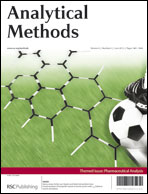Three enantioselective, potentiometric membrane electrodes (EPMEs) based on C60 fullerene and its derivatives, (1,2-methanofullerene C60)-61-carboxylic acid and tert-butyl(1,2-methanofullerene C60)-61-carboxylate, were designed for the enantioanalysis of ketoprofen. Molecular modelling has been used to investigate the enantioselective binding between the enantiomers of ketoprofen and C60 fullerenes and to prove the mechanism of potential development for the proposed electrodes. The slopes obtained for these electrodes are near-Nernstain with detection limits of 10−8 and 10−7 mol L−1 magnitude order. The proposed electrodes can be reliably used for the enantioanalysis of ketoprofen raw material as well as from its pharmaceutical formulations. Electronic structures as well as molecular interaction have been investigated using Hartree–Fock theory, 3-21G(*) basis set. Stability and feasibility of all the generated structures were supported by their respective energy minima and fundamental frequencies. Molecular modeling calculations were in good agreement with the performances of the proposed electrodes.

You have access to this article
 Please wait while we load your content...
Something went wrong. Try again?
Please wait while we load your content...
Something went wrong. Try again?


 Please wait while we load your content...
Please wait while we load your content...